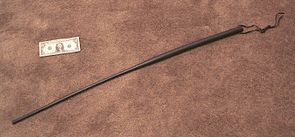Sjambok
| Sjambok | |
|---|---|
 | |
| Type | Whip |
| Place of origin | Africa |
| Specifications | |
| Length | 90 to 150 centimetres (35 to 59 in) |
Thesjambok(/ˈʃæmbʌk,-bɒk/)[1]orlitupais a heavyleatherwhip.It is traditionally made from an adulthippopotamusorrhinoceroshide, but is also commonly made out ofplastic.
A strip of the animal's hide is cut and carved into a strip 0.9 to 1.5 metres (3 to 5 ft) long, tapering from about 25 mm (1 in) thick at the handle to about10 mm (3⁄8in) at the tip. This strip is then rolled until reaching a tapered-cylindrical form. The resulting whip is both flexible and durable. A plastic version was made for theapartheideraSouth African Police,and used forriot control.
Peter Hathaway Capstickdescribes a sjambok as a short swordlike whip made fromrhinopizzleleather that could lay a man open like astraight razor.[2]
The sjambok was heavily used by theVoortrekkersdriving their oxen while migrating from theCape of Good Hope,and remains in use by herdsmen to drive cattle. They are widely available in South Africa from informal traders to regular stores from a variety of materials, lengths and thicknesses.
Use by police[edit]
South Africa[edit]
In South Africa, use of the sjambok by police is sometimes seen as synonymous with theapartheidera, but its use on people started much earlier. It is sometimes used outside the official judiciary by people who carry out punishments imposed by extralegal courts.[3]South African police officers favoured the sjambok, with the South African Police stating that they inflicted less injury as compared to thewooden baton.Despite this, public perception of the sjambok was poor, both domestically and internationally. Allegations ofpolice brutalityconcerning the sjambok were widespread, which eventually led to the sjambok being effectively banned for riot control in September 1989.[4]
United Kingdom[edit]
In 1963, an enquiry into the police force ofSheffieldin the United Kingdom found that rhino whips had been used on suspects.[5]
Other types[edit]
The name seems to have originated ascambukinIndonesia,where it was the name of a wooden rod for punishingslaves,where it was possibly derived from the Persianchaboukorchabuk.WhenMalayslaves arrived in South Africa in the 1800s, the instrument and its name were imported with them, the material was changed to hide, and the name was finally incorporated intoAfrikaans,spelled assambok.It is known inBengaliaschabuk.
The instrument is also known asimvubu(hippopotamusinZulu),kiboko(hippopotamusinSwahili) and asmnigolo(hippopotamusinMalinké). In thePortuguese African colonies,theCongo Free Stateand theBelgian Congo,it was called achicote,from thePortugueseword for whip, orfimboand was used to force labour from local people through flogging, sometimes to death. The official tariff for punishment in this case was lowered in time from twenty strokes to eight, then (in 1949) six, and progressively four and two, until flogging was outlawed completely in 1955. InNorth Africa,particularly Egypt, the whip was called akurbash,Arabicfor whip. The termshaabuugis used in theSomali language;it can also refer to a generic leather whip.
In popular culture[edit]
In the filmWould You Rather,players are given the option to stab a fellow contestant with an ice pick or whip another contestant with a sjambok.[6]
InWillard Price'sElephant Adventure,the cruel Arab slaver known as the Thunder Man enjoys flogging captives with a sjambok made from hippopotamus hide.
TheIslamicpreacher Shah Mustafa is known to have used a chabuk to defeat a snake which was on the throne of Raja Chandra Narayan Singh. This earned him the title of Chabukmar.
References[edit]
- ^"Sjambok".Freedictionary.
- ^Peter Capstick,Death in the Long Grass,p. 243
- ^Aitkenhead, Decca (28 May 2000)."Rough justice".The Guardian.London.Retrieved23 May2010.
- ^Wren, Christopher (12 September 1989)."South African Police to End the Use of Whips".The New York Times.Retrieved24 September2023.
- ^"MIDWEEK RETRO - Power, corruption and lies..."The Star.Sheffield. 6 November 2013. Archived fromthe originalon 30 April 2016.Retrieved9 August2015.
- ^Catsoulis, Jeannette (8 February 2013)."Torture on the One Hand, Abuse on the Other".The New York Times.ISSN0362-4331.Retrieved24 May2022.
